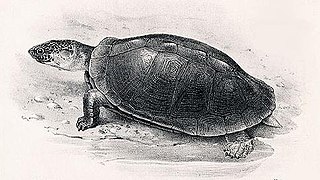
The Mexican box turtle is a species of box turtle belonging to the family Emydidae. It is sometimes treated as a subspecies of Terrapene carolina.

Pelusios is a genus of African side-necked turtles. With 17 described species, it is one of the most diverse genera of the turtle order (Testudines).

Cycloderma is a genus of softshell turtles in the subfamily Cyclanorbinae of the family Trionychidae. The genus is endemic to Africa.
Pelusios broadleyi, commonly known as the Turkana mud turtle, Broadley's mud turtle, or the Lake Turkana hinged terrapin, is a species of turtle in the family Pelomedusidae. The species is native to eastern Africa.

The yellow-bellied mud turtle is a species of turtle in the family Pelomedusidae. It is found in Madagascar, Malawi, Mozambique, Seychelles, South Africa, and Tanzania.
The variable mud turtle, also known as Rhodesian mud turtle, Mashona hinged terrapin or variable hinged terrapin, is a species of turtle in the family Pelomedusidae. It is widely distributed in Central, East, and Southern Africa. The species was officially described by John Hewitt in 1927 and had to be broken into subspecies due to color variations on the heads of the turtles acrost the regions.

The East African black mud turtle, also known as the Pan terrapin, is a species of turtle in the family Pelomedusidae, native to eastern and southeastern Africa.

The Rio Grande cooter is a species of turtle in the family Emydidae. The species is native to northeastern Mexico and the adjacent southwestern United States.

The Central Antillean slider is a species of turtle in the family Emydidae. The species is found on three islands in the West Indies: Hispaniola, Great Inagua, and Puerto Rico.

Phrynops williamsi, also known commonly as Williams' side-necked turtle, Williams' South American sideneck turtle, William's [sic] South American side-necked turtle, William's [sic] toadhead turtle, and Williams' toadhead turtle, is a species of turtle in the family Chelidae. The species is endemic to South America.

The West African mud turtle, also known as the West African side-necked turtle or swamp terrapin, is a species of turtle in the family Pelomedusidae. Pelusios castaneus is a freshwater species and is endemic to West and Central Africa.

Adanson's mud turtle is a species of turtle in the family Pelomedusidae. The species is endemic to north-central Africa.

The Okavango mud turtle or Okavango terrapin) is a species of turtle in the family Pelomedusidae endemic to Africa. It is found in Angola, Botswana, the Democratic Republic of the Congo, Namibia (Caprivi), Zambia, and Zimbabwe.
The African keeled mud turtle is a species of turtle in the family Pelomedusidae. It is endemic to central Africa : the Democratic Republic of the Congo, the Republic of the Congo, and Gabon.
The Central African mud turtle is a species of turtle in the family Pelomedusidae. The species is endemic to Central Africa.
The Ivory Coast mud turtle is a species of turtle in the family Pelomedusidae. It is one of the most recently described turtle species.
The Pelusios cupulatta is typically found in riverine and wetland habitats mainly located in the southern Ivory Coast of West Africa. Endemic to the Upper Guinean forest region such as wetlands/rivers they are usually found primarily in forested banks as well as aquatic vegetation. Compared to other counterparts within its family, P. Cupulatta prefers an abundance of aquatic vegetation as its primary habitat. Despite this, Pelusios castaneus is a potential competitor due to similar habitats albeit different preferences regarding specific locations. Interspecific competition is able to regulate the coexistence of potential competitors but also niche expansion is available within the family when alone.
Comparative to other species at a local spatial level, Pelusios niger and Pelusios cupulatta both belong to larger size categories compared to others within the Pelusios records with the maximum male SCL being 31.3 and the maximum female SCL being 27.1. The two different turtle species are also allopatric, meaning that they are related but occur in separate non-overlapping geographical areas compared to the sympatric of P. castaneus. White P. castaneus intensely uses forested banks, P, and cupulatta aren't typically found in such areas as they aim for places with large amounts of aquatic vegetation. In presence of P. niger, P. cupulatta are usually found less than 10 km away showing how closely these two groups typically reside at roughly close locations.

The African forest turtle is a species of turtle in the family Pelomedusidae. It is endemic to Africa, where it can be found in Angola, Burundi, Cameroon, Equatorial Guinea, Gabon, the Democratic Republic of the Congo, the Republic of the Congo, Ghana, Tanzania, and Uganda
Pelusios marani, also known as the Gabon mud turtle, is a species of turtle in the family Pelomedusidae. This species is endemic to Africa.
The African dwarf mud turtle is a species of turtle in the family Pelomedusidae. It is endemic to Africa : in Angola, the Democratic Republic of the Congo, Malawi, and Zambia. These mud turtles are the smallest of all African turtle species, “Nanus” which they are referred to are one of the 3 smallest turtle species in the world. The other two are Stink Pot Musk and Muhlenberg's Bog Turtles. All 3 species barely reach 4 inches as full grown adults. Like many of the world's chelonians, Pelusios castaneus has the potential to live a long life. Reports typically suggest more than 50 years in captivity for this species.

The West African black turtle is a species of turtle in the family Pelomedusidae. It is endemic to Africa, in Cameroon, Equatorial Guinea, Gabon, and Nigeria.














